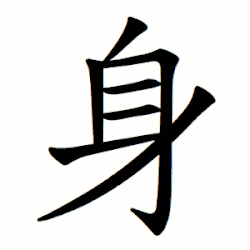Radical 158
| 身 | ||
|---|---|---|
| ||
| 身 (U+8EAB) "body" | ||
| Pronunciations | ||
| Pinyin: | shēn | |
| Bopomofo: | ㄕㄣ | |
| Wade–Giles: | shen1 | |
| Cantonese Yale: | san1 | |
| Jyutping: | san1, gyun1 | |
| Japanese Kana: | シン shin (on'yomi) み mi (kun'yomi) | |
| Sino-Korean: | 신 sin | |
| Hán-Việt: | thân | |
| Names | ||
| Chinese name(s): | 身字旁 shēnzìpáng | |
| Japanese name(s): | 身/み mi 身偏/みへん mihen | |
| Hangul: | 몸 mom | |
| Stroke order animation | ||
 | ||
Radical 158 or radical body (身部) meaning "body" is one of the 20 Kangxi radicals (214 radicals in total) composed of 7 strokes.
In the Kangxi Dictionary, there are 97 characters (out of 49,030) to be found under this radical.
身 is also the 160th indexing component in the Table of Indexing Chinese Character Components predominantly adopted by Simplified Chinese dictionaries published in mainland China.
Evolution
-
 Oracle bone script character
Oracle bone script character -
 Bronze script character
Bronze script character -
 Large seal script character
Large seal script character -
 Small seal script character
Small seal script character
Derived characters
| Strokes | Characters |
|---|---|
| +0 | 身 |
| +3 | 躬 |
| +4 | 躭 (=耽 -> 耳) 躮 躯SC/JP (=軀) |
| +5 | 躰 (=體 -> 骨) |
| +6 | 躱 (=躲) 躲 |
| +7 | 躳 (=躬) 躴 躵 |
| +8 | 躶 (=裸 -> 衣) 躷 (=矮 -> 矢) 躸 躹 躺 躻 躼 |
| +9 | 躽 躾 |
| +10 | 躿 |
| +11 | 軀 軁 |
| +12 | 軂 軃 (=躲 / 嚲 -> 口) 軄 (=職 -> 耳) 軅JP (=軈) |
| +13 | 軆 (=體 -> 骨) |
| +14 | 軇 |
| +17 | 軈JP |
| +20 | 軉 |
Sinogram
The radical is also used as an independent Chinese character. It is one of the Kyōiku kanji or Kanji taught in elementary school in Japan.[1] It is a third grade kanji.[1]
References
- ^ a b "The Kyoiku Kanji (教育漢字) - Kanshudo". www.kanshudo.com. Archived from the original on March 24, 2022. Retrieved 2023-05-06.
Literature
- Fazzioli, Edoardo (1987). Chinese calligraphy : from pictograph to ideogram : the history of 214 essential Chinese/Japanese characters. calligraphy by Rebecca Hon Ko. New York: Abbeville Press. ISBN 0-89659-774-1.
External links
Wikimedia Commons has media related to Radical 158.